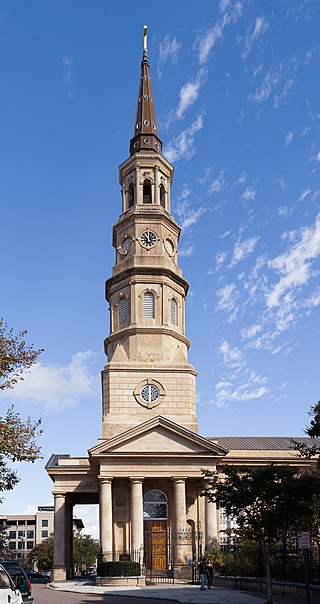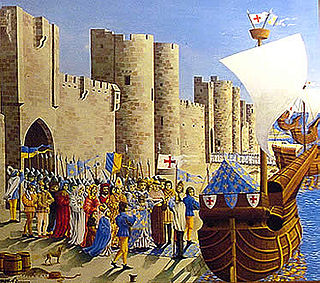Related Research Articles

The Anglican Communion is the third largest Christian communion after the Roman Catholic and Eastern Orthodox churches. Founded in 1867 in London, the communion has more than 85 million members within the Church of England and other autocephalous national and regional churches in full communion. The traditional origins of Anglican doctrine are summarised in the Thirty-nine Articles (1571). The archbishop of Canterbury in England acts as a focus of unity, recognised as primus inter pares, but does not exercise authority in Anglican provinces outside of the Church of England. Most, but not all, member churches of the communion are the historic national or regional Anglican churches.

The flag of England is the national flag of England, a constituent country of the United Kingdom. It is derived from Saint George's Cross. The association of the red cross as an emblem of England can be traced back to the Late Middle Ages when it was gradually, increasingly, used alongside the Royal Banner. It became the only saint's flag permitted to be flown in public as part of the English Reformation and at a similar time became the pre-eminent maritime flag referred to as a white ensign. It was used as a component in the design of the Union Jack in 1606.
The Continuing Anglican movement, also known as the Anglican Continuum, encompasses a number of Christian churches, principally based in North America, that have an Anglican identity and tradition but are not part of the Anglican Communion.

The Reformed Episcopal Church (REC) is an Anglican church of evangelical Episcopalian heritage. It was founded in 1873 in New York City by George David Cummins, a former bishop of the Protestant Episcopal Church.

The Episcopal Diocese of New York is a diocese of the Episcopal Church in the United States of America, encompassing three New York City boroughs and seven New York state counties. Established in 1785, it is one of the Episcopal Church's original dioceses. The current diocesan bishop is the Rt. Rev. Matthew Heyd, whose seat is at the Cathedral of Saint John the Divine.

The Episcopal Diocese of Georgia, USA is one of 20 dioceses that comprise Province IV of the US Episcopal Church, and is a diocese within the worldwide Anglican Communion. The current bishop is Frank S. Logue, who succeeded Scott Anson Benhase on May 30, 2020, when he was consecrated 11th bishop of Georgia at a service held in Christ Church in Savannah, Georgia.

The Anglican Diocese of South Carolina (ADOSC) is a diocese of the Anglican Church in North America (ACNA). The diocese covers an area of 24 counties in the eastern part of the state of South Carolina. In 2019, it had 18,195 baptized members and 47 parishes. The see city is Charleston, home to the Cathedral of St. Luke and St. Paul.

The Anglican Diocese of Quincy is a member of the Anglican Church in North America and is made up of 32 congregations, principally in Illinois but also in Wisconsin, Minnesota, Texas, Iowa, Nebraska, Missouri, Hawai'i, Colorado, Tennessee, and Florida in the United States. The diocese was a founding member of the Anglican Church in North America in 2009.

The Episcopal Diocese of Pittsburgh is a diocese in the Episcopal Church in the United States of America. Geographically, it encompasses 11 counties in Western Pennsylvania. It was formed in 1865 by dividing the Episcopal Diocese of Pennsylvania. The diocesan cathedral is Trinity Cathedral in downtown Pittsburgh. The Rt. Rev. Ketlen A. Solak was consecrated and seated as its current bishop in autumn 2021.
In the United States, the history of the Episcopal Church has its origins in the Church of England, a church which stresses its continuity with the ancient Western church and claims to maintain apostolic succession. Its close links to the Crown led to its reorganization on an independent basis in the 1780s. In the nineteenth and early twentieth centuries, it was characterized sociologically by a disproportionately large number of high status Americans as well as English immigrants; for example, more than a quarter of all presidents of the United States have been Episcopalians. Although it was not among the leading participants of the abolitionist movement in the early 19th century, by the early 20th century its social engagement had increased to the point that it was an important participant in the Social Gospel movement, though it never provided much support for the Prohibitionist movement. Like other mainline churches in the United States, its membership decreased from the 1960s. This was also a period in which the church took a more open attitude on the role of women and toward homosexuality, while engaging in liturgical revision parallel to that of the Roman Catholic Church in the post Vatican II era.
The Anglican realignment is a movement among some Anglicans to align themselves under new or alternative oversight within or outside the Anglican Communion. This movement is primarily active in parts of the Episcopal Church in the United States and the Anglican Church of Canada. Two of the major events that contributed to the movement were the 2002 decision of the Diocese of New Westminster in Canada to authorise a rite of blessing for same-sex unions, and the nomination of two openly gay priests in 2003 to become bishops. Jeffrey John, an openly gay priest with a long-time partner, was appointed to be the next Bishop of Reading in the Church of England and the General Convention of the Episcopal Church ratified the election of Gene Robinson, an openly gay non-celibate man, as Bishop of New Hampshire. Jeffrey John ultimately declined the appointment due to pressure.

The Diocese of the Holy Cross (DHC) is a constituent diocese of the Anglican Catholic Church, a continuing Anglican church body in the United States. Unlike most dioceses, it is not geographically defined.

The Anglican Church in North America (ACNA) is a Christian denomination in the Anglican tradition in the United States and Canada. It also includes ten congregations in Mexico, two mission churches in Guatemala, and a missionary diocese in Cuba. Headquartered in Ambridge, Pennsylvania, the church reported 977 congregations and 124,999 members in 2022. The first archbishop of the ACNA was Robert Duncan, who was succeeded by Foley Beach in 2014.

St. Michael's AnglicanChurch is a historic church and the oldest surviving religious structure in Charleston, South Carolina. It is located at Broad and Meeting streets on one of the Four Corners of Law, and represents ecclesiastical law. It was built in the 1750s by order of the South Carolina Assembly. It is listed on the National Register of Historic Places and is a National Historic Landmark.

St. Philip's Church is an historic church at 142 Church Street in Charleston, South Carolina. Its National Historic Landmark description states: "Built in 1836, this stuccoed brick church features an imposing tower designed in the Wren-Gibbs tradition. Three Tuscan pedimented porticoes contribute to this design to make a building of the highest quality and sophistication." On November 7, 1973, it was added to the National Register of Historic Places and designated a National Historic Landmark.

The Episcopal Church (TEC), based in the United States with additional dioceses elsewhere, is a member church of the worldwide Anglican Communion. It is a mainline Protestant denomination and is divided into nine provinces. The presiding bishop of the Episcopal Church is Michael Bruce Curry, the first African American bishop to serve in that position.

The Diocese of Quincy was a diocese of the Episcopal Church in western Illinois from 1877 to 2013. The cathedral seat was originally in Quincy, Illinois but was moved to St. Paul's Cathedral in Peoria in 1963. In order to avoid confusion with the Roman Catholic Diocese of Peoria, the diocese retained the name of the location of its original "home" city, Quincy, where its cathedral seat was St. John's.

The Episcopal Diocese of South Carolina (EDOSC), known as The Episcopal Church in South Carolina from January 2013 until September 2019, is a diocese of the Episcopal Church. The diocese covers an area of 24 counties in the eastern part of the U.S. state of South Carolina. The see city is Charleston, home to Grace Church Cathedral and the diocesan headquarters. The western portion of the state forms the Episcopal Diocese of Upper South Carolina. As a diocese of the Episcopal Church, the Diocese of South Carolina is part of the worldwide Anglican Communion and traces its heritage to the beginnings of Christianity.

The history of Christian flags encompasses the establishment of Christian states, the Crusader era, and the 20th century ecumenical movement.
The Episcopal Diocese of South Carolina was established in 1785 as one of the nine original dioceses of the Episcopal Church in the United States. The diocese originally covered the entire state of South Carolina, but the western part of the state became the Episcopal Diocese of Upper South Carolina in 1922. In 2012, a controversy led to the existence of two rival dioceses, the Anglican Diocese of South Carolina and the Episcopal Diocese of South Carolina, each claiming to be the legitimate successor of the original diocese.
References
- ↑ Podmore, Colin (January 2008). "A Tale of Two Churches: The Ecclesiologies of The Episcopal Church and the Church of England Compared". Ecclesiastical Law Journal. 10 (1): 34–70. doi:10.1017/S0956618X08000896. ISSN 1751-8539 . Retrieved 16 February 2024.